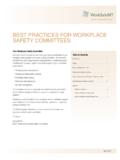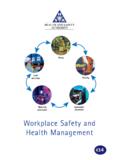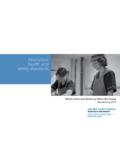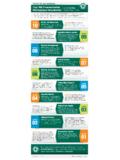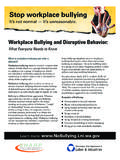Transcription of HealthandSafety Executive Workplace health, safety …
1 IntroductionThe Wor kpla ce (Heal th, safety and Welfare)Regulations 1992 co ver a wid e rangeof basi c he alth , safet y and wel fare issu es an d app ly to mos t workp laces (wit h theexce pti on of th ose wo rkplacesinvo lvin g con stru ction work on cons truct ion sites,thos e in or on a shi p, or tho se bel ow gro un d at a mine) . They are amend ed by theQua rr ies Reg ula tion s 199 9, th e Healt h an d safety (Miscellaneous Amen dmen ts)Re gul atio ns 2002, the Work at Hei gh t Regu lations 2005 , and th e Con stru ct ion(De sig n an d Man agem ent) Regul ati on s 200 s leafl et gi ves a bri ef outl ine of th e requ iremen ts of th e Workp lace Regulat uirements under thes e Reg ulat ionsEm pl oyer s have a generaldut y und er sect ion 2 of th e Health an d Safet y at Worketc Act 1974 to en sure, so far as is reas onab ly practicable,th e healt h, safet y andwel fare of th eir empl oyees at wo rk.
2 Peop le in co ntro l of non-d omesticpremis eshave a du ty (und er secti on 4 of the Act ) tow ards peop le wh o are not theiremp loye es but use thei r prem ises. Th e Regu lations exp and on th ese duties andare inte nde d to pro tect th e heal th and safet y of everyone in th e workp lace, andens ure tha t ad equat e welfare faci lities are providedfor peop le at e Regu lat ion s ai m to ens ure th at wo rkplacesmeet the health , safety andwel fare need s of all mem bers of a workfo rce, includ ing peo ple with disabili ti ra l of the Regul ati ons requ ire th ing s to be su itab le . Regu lation 2(3) makes itclea r that thi ngs sho ul d be sui tabl e for anyon e.
3 Th is inclu des peo ple withdis abi lities . Wh ere necess ary, parts of th e wo rkplace,inclu ding in part icu lar do ors,pas sage ways , stai rs, show ers, wash basin s, lavato ries and wo rkstations, sh ould bemad e ac cess ible for disabled peop ion Wo rkp lac e - thes e Regul ati on s app ly to a very wide range of workp laces, no t onlyfacto ri es, shop s an d offi ces but al so, fo r example,sch ools, hosp itals, hotel s andpla ces of en ter tai nm ent. The term workp lace also inclu des th e commonpart s ofsha red bui lding s, pri vate roads an d pat hs on indust rial es tates an d bu sin ess parks,and tem por ar y works ites (except workp laces involvin g co nst ruction wo rk oncons tr uct ion si tes).
4 Wo rk - mean s work as an emp loyee or self-employed pers on. P rem ises - means any pl ace incl ud ing an outd oor ,safetyandwelfareA short gui de for managers1 of 8 pag esThisisaweb-friendlyversionofleafletIND G244(rev2)He alth and SafetyExe cut iveWo rkp lac e healt h, sa fet y an d welf are: A short guide for managers Dom esti c prem ises - mean s a pri vate dwelling . Thes e Regulations do not apply todom est ic prem ises, and excl ude ho mew orkers. How ever , they do ap ply to hotels,nur sing hom es and to part s of workp laces wh ere d omestic staff are emplo yed,suc h as th e kit chens of ho stel s. Disabl ed per son - has the meani ng given by section1 of the Disab ilit yDis cr iminatio n Act 19 mea sur es outl ined in thi s sect ion co ntrib ut e to the general wo rkin genvi ronm en t of peop le in the wo rkp kpla ces need to be adequ atel y ven tilated.
5 Fresh , clean air sho uld be draw nfrom a sour ce ou ts ide the wo rkpl ace, un con tami nated by disch arges from fl ues,chi mn eys or othe r pro ces s out lets, an d be ci rcu lated th roug h the nti lati on sho uld al so rem ove an d dilu te warm, hu mid air an d provid e airmove men t whic h gives a sens e of fresh ness with out caus ing a drau gh t. If thewor kpl ace cont ains pro cess or heat ing eq uipment or ot her sources of dust , fumesor vapo ur s, more fresh air wi ll be need ed to provid e ad eq uate ven til at dow s or other openi ng s may pro vid e su fficient ven tilation but, where necessary,mec han ica l ven til ati on sys tem s shoul d be provid ed and regu larly main tain ures in indoor wo rkp lacesEn vi ro nm ent al facto rs (suc h as humi dity and sources of hea t in the Workplace ) co mb inewi th pe rso na l fac to rs (such as the cl othing a worker is wearing and how physical lyde ma nd ing th ei r wo rk is)
6 To influe nce what is called someo ne s thermalcomfo rt .Ind ivi dua l per son al preferencemakes it difficu lt to specify a thermal en viro nme ntwhi ch sati sfi es everyone. For wor kpl aces where the act ivity is main ly sed ent ar y, forexam pl e of fic es, th e tem perat ure sh ou ld normall y be at least 16 C. If work involvesphys ica l ef for t it shoul d be at leas t 13 C (un less oth er law s req uire lowertem per atu res ).Wo rk in hot or co ld en vi ro nm ent sThe ri sk to th e he alt h of wo rkers increasesas cond ition s move fu rth er away fromthos e ge ner al ly ac cepted as comfortable. Risk of heat stress arises , for example,from wo rki ng in hi gh air tem peratu res, exp osu re to high th ermal rad iation or highlevel s of hu mi di ty, such as thos e fou nd in fou nd ries, glass works an d lau ndrie d stres s may ari se, fo r exam pl e, from workin g in cold stores, fo od prep arationareas an d in th e open ai r durin g wi ses sm ent of th e ri sk to wo rkers health from workin g in either a ho t or co ldenvi ronm en t ne eds to co nsi der bot h person al an d en viron men tal facto rs.
7 Personalfacto rs inclu de bod y acti vi ty, the am ou nt and typ e of clo thin g, an d duration ofexp osu re. Envir onm ental fact ors incl ude amb ient temperature an d radian t hea t; andif the wor k is ou tsi de, sun light , wi nd velocityan d th e pres ence of rain or sno of 8 pag esWo rkp lac e healt h, sa fet y an d welf are: A short guide for managersHe alth and SafetyExe cut ive3 of 8 pag esWo rkp lac e healt h, sa fet y an d welf are: A short guide for managersAct ion s ar isin g from your ass essment may includ e: introd uci ng eng ineeri ng meas ures to co ntro l th e th ermal effect s in a workplaceenvi ron men t, fo r exam pl e hea t effects , may involve insulatin g an y plan t whichacts as a rad iant heat so urce, thereb y improving air movement, increasingvent ila tion rates and mai nt ain ing the ap propriatelevel of hu midity.
8 Th e rad ianthea t ef fects of the sun on indoor en viron men ts can be ad dres sed eit her byor ien tati ng the bui ldi ng so that it doesn t suffer from th e effects of solar loading,or wh ere thi s is no t po ssi bl e, by the use of blin ds or sh utters on ere wor kers are ex pos ed to col d an d it is no t reason ab ly practicable toavoi d ex pos ure yo u sho ul d con si der , for example,using cab heaters in fork-lifttr ucks in col d st ores; res tr icti on of ex pos ure by , for exam pl e,re- or gan isi ng tasks to buil d in rest period s or other breaks from work. Th is willall ow wor ker s to rest in an area wh ere th e en viro nmen t is comfortable an d, ifnec ess ar y, to repl ace bo di ly fl uids to comb at dehyd ration or cold.
9 If work ratescau se exces si ve sweat ing , wo rkers may need more frequ en t rest breaks and afaci lity for chan ging int o dry cl oth ing; me dic al pre- sel ecti on of emp loyees to ensu re th at they are fit to work in th eseenvi ron men ts ; us e of sui tab le person al prot ect ive cl ot hin g (wh ich may need to be heatres ist ant or insul ati ng, dep endi ng on wh eth er th e risk is fro m heat or cold); accl imati sati on of workers to the en vi ro nmen t in which th ey work, particu larlyfor hot en viro nm ents ; tr ain ing in th e precaut ions to be taken ; an d sup erv isi on, to ensu re that the precautionsidentifiedby the assessmentare taken.
10 Fur th er ad vice on therm al com fort in th e workp lace can be fou nd on HSE s websiteat: ww w. hs e. gov .uk/ tem perature/thermalLig htin gLig hti ng shou ld be suf fici ent to enab le peop le to work an d mo ve abo ut safely . Ifnece ssa ry, local lig hti ng sh oul d be provid ed at ind ivid ual workstations and at placesof par ticu lar risk su ch as cros si ng po ints on traffic rou tes. Light ing an d light fittingssho uld no t cre ate any hazard .Au tom atic em er gency light ing , po wered by an indep end en t sou rce, sh ou ld beprovi ded wh ere su dden los s of ligh t wou ld create a ri an d was te mat eri alsEver y wor kpl ace and the fu rni tu re, fu rnish ings and fittin gs shou ld be kep t cl ean andit shou ld be pos sib le to keep the su rfaces of floors, walls an d ceilin gs ani ng and the remo val of waste shou ld be carried ou t as necess ary by aneffe ctive me thod.










